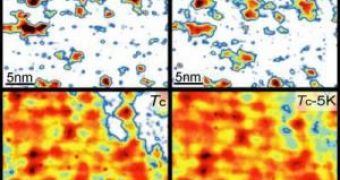Superconductivity is a phenomenon occurring in certain materials at extremely low temperatures, characterized by exactly zero electrical resistance and the exclusion of the interior magnetic field. They are thought to appear usually below -140 degrees Celsius.
A team of researchers at Princeton University used a customized microscope to map the strength of current-carrying electron pairs as they form in a ceramic superconductor, thus proving that superconductivity can appear inside these ceramic materials even when they are warmed up above the critical temperature where they lose their resistance.
Ali Yazdani is a professor of physics at Princeton and the lead author of the research paper and he stated that when superconductors are warmed up, not all their properties are lost, and so disconnected regions only a few nanometers wide in some materials at up to 50 degrees above the critical temperature, possess Cooper pairs, the coupled electrons that carry current through a superconductor, which previously were only known to appear below the critical temperature at which a material superconducts.
"Our measurements show that Cooper pairs survive in local patches of the material at temperatures far above the critical temperature," said Yazdani, a professor of physics at Princeton. "Within these tiny regions, there are particular arrangements of atoms that favor formation of electron pairs at very high temperatures. These patches are a precursor to superconductivity and important to enhancing it."
This is a fragrant contradiction of older theories, so the newly found high-temperature superconductivity in ceramics defies a widely accepted explanation and is considered one of the major puzzles in physics.
"In lower temperature superconductors, electrons pair up and form a superfluid at the critical temperature - end of story," Yazdani said. "In ceramics, however, our team is finding that electron pairing occurs over a wide range of temperatures, and their pairing is a function of highly localized chemistry in the sample, often in patches only a few atoms wide."
When researchers will better understand the details of what is happening with the local patches within the ceramic samples, they could use the information in practical applications, which would have a greater overall performance.
"If we could raise the critical temperature by making the sample more homogeneous, then superconductivity's application to day-to-day technologies, such as power grids, becomes much more realistic," said Mike Norman, a physicist in Argonne National Laboratory's Materials Science Division. "The nice thing with superconductors is that there is no power loss, so they could be a major player in 'green' and 'efficient' technologies for power transmission."

 14 DAY TRIAL //
14 DAY TRIAL //